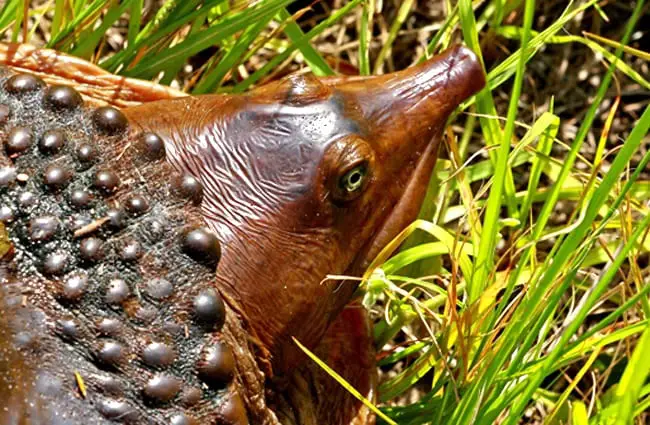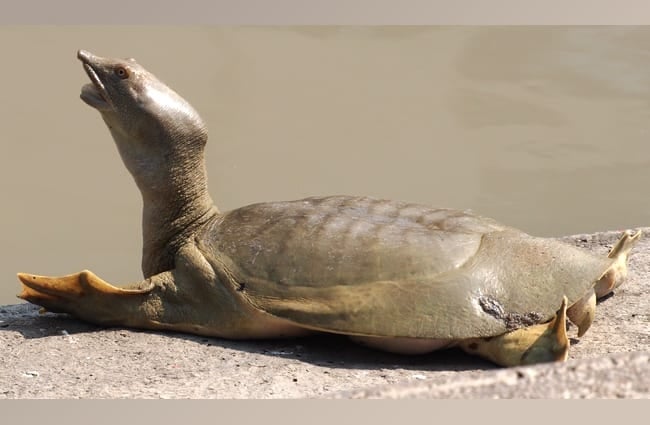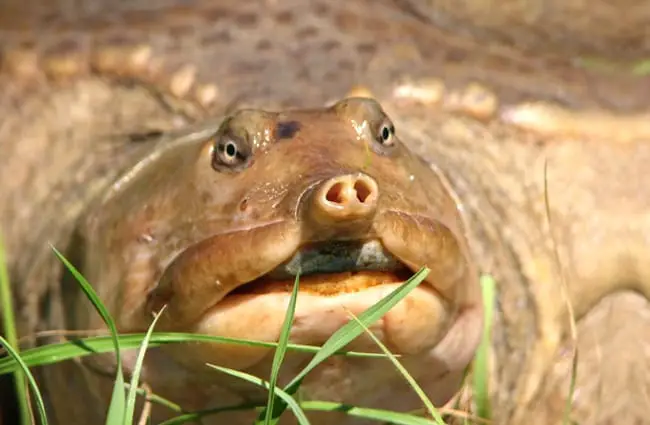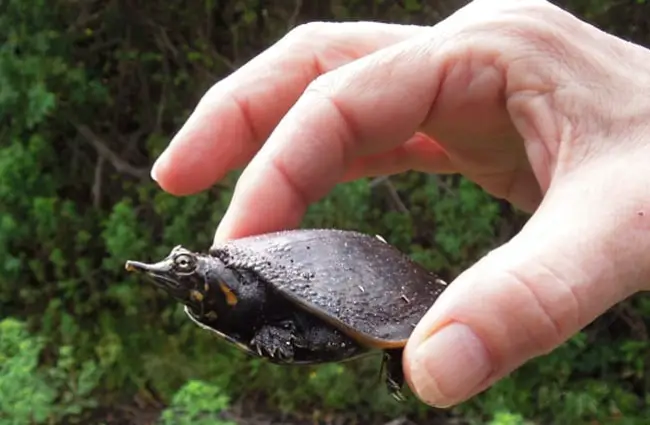Unveiling the Enigmatic Softshell Turtle
Softshell turtles are a fascinating group within the turtle order, distinguished by their flattened bodies and leathery shells. These ancient reptiles are found across the Americas and Asia, thriving in a variety of freshwater habitats. Their unique morphology and behavior make them a captivating subject for both amateur nature enthusiasts and dedicated researchers.

A Deep Dive into Softshell Turtle Biology
Distinctive Physical Characteristics
The most striking feature of softshell turtles is their shell. Unlike the hard, domed shells of many other turtle species, softshells possess a flexible, leathery carapace. This shell is made of bone covered by skin, lacking the scutes (scales) found on most turtles. The reduced shell weight and rigidity give softshells a streamlined shape that enhances their agility in the water. Their elongated snouts, which resemble a hybrid between a turtle and a duck, aid in ambush predation. Webbed feet allow them to navigate muddy bottoms and swim swiftly.
Habitat and Distribution
Softshell turtles occupy a wide range of freshwater habitats. In North America, the Florida Softshell Turtle (Apalone ferox) is commonly found in slow‑moving rivers, lakes, and swamps with sandy or muddy bottoms. In Asia, the Chinese Softshell Turtle (Pelodiscus sinensis) lives in similar environments and can also enter brackish water. These turtles favor areas with abundant vegetation and basking sites. They thrive in warmer climates and avoid extremely cold temperatures.

Dietary Habits
Softshell turtles are opportunistic predators. Their diet varies with species, age, and habitat, but generally includes fish, insects, crustaceans, amphibians, and occasionally small mammals. They are ambush predators that bury themselves in sediment with only their eyes and nostrils exposed, waiting for prey to swim by. Powerful jaws and sharp beaks allow them to capture and consume their meals quickly.
The Evolutionary History of Softshell Turtles
Fossil records indicate that softshell turtles have a long evolutionary history that dates back to the late Cretaceous period—over 90 million years ago. They are among the oldest living groups of turtles. Their ancestors likely inhabited marine environments and gradually adapted to freshwater habitats. The streamlined shape of their bodies and the flexible shell evolved to enhance swimming speed and hunting efficiency, making them agile predators in their environments.

Reproduction and Life Cycle
Softshell turtles typically breed in spring or summer. Males attract females through elaborate courtship displays that involve underwater movements and tactile interactions. Females lay their eggs in sandy nests near the water’s edge. Clutch sizes vary by species, usually ranging from 10 to 30 eggs. The eggs incubate for several weeks before hatchlings emerge, fully formed but vulnerable to predation. Juvenile softshell turtles grow rapidly, reaching sexual maturity within a few years. In the wild, their lifespan can exceed 30 years, though it varies considerably.
Ecological Role and Interactions
Softshell turtles play an important role in maintaining the health of freshwater ecosystems. As predators, they help control populations of fish, invertebrates, and other aquatic organisms. They also contribute to nutrient cycling through their feeding and waste products, which enrich the surrounding environment. Softshell turtles interact with other animals in various ways. Larger fish and mammals may prey on young turtles, and birds sometimes target eggs. These reptiles often share habitats with other turtle species and may compete for resources.

Softshell Turtles and Human Interactions
Historically, softshell turtles were harvested for their meat, which was considered a delicacy in some cultures. Today, many species face threats from habitat loss, pollution, overharvesting, and entanglement in fishing gear. In some regions, softshell turtles are raised in aquaculture facilities for food. It is crucial to support conservation efforts that protect these fascinating reptiles and their habitats.
Finding Softshell Turtles in the Wild
If you hope to observe softshell turtles in the wild, focus on slow‑moving rivers, lakes, and swamps with sandy or muddy bottoms. Look for individuals basking on logs or submerged vegetation. Approach cautiously and avoid disturbing their habitat. Observe from a distance and respect their space.
Encountering a Softshell Turtle
If you encounter a softshell turtle while hiking or swimming, leave it undisturbed. Avoid touching or handling the animal, as this can cause stress. If the turtle appears injured or sick, contact a local wildlife rehabilitation center for assistance.

Caring for Softshell Turtles in Captivity
Keeping softshell turtles in captivity requires specialized knowledge and resources. They need a large, well‑maintained aquarium with a sandy substrate and ample swimming space. Water quality is crucial; regular filtration and water changes are essential. Their diet should include a variety of fish, invertebrates, and commercially available turtle pellets. Provide basking areas with appropriate lighting and temperature. Regular veterinary checkups are also important.
Fascinating Facts About Softshell Turtles
- Softshell turtles can breathe through their cloaca, allowing them to stay submerged for extended periods.
- They are surprisingly fast swimmers, capable of pursuing prey with great agility.
- While most species exhibit limited parental care, some show brief protective behaviors toward their nests.
- Their shells are highly sensitive to touch.
- Juvenile softshells have a distinctive dark pattern on their carapaces that fades with age.
Softshell turtles are truly remarkable creatures, representing a unique and ancient lineage within the turtle order. By understanding their biology, ecology, and conservation needs, we can help ensure that these fascinating reptiles continue to thrive for generations to come.

![Red Angus Closeup of a beautiful Red Angus cowPhoto by: U.S. Department of Agriculture [pubic domain]https://creativecommons.org/licenses/by/2.0/](https://animals.net/wp-content/uploads/2020/03/Red-Angus-4-238x178.jpg)




![Red Angus Closeup of a beautiful Red Angus cowPhoto by: U.S. Department of Agriculture [pubic domain]https://creativecommons.org/licenses/by/2.0/](https://animals.net/wp-content/uploads/2020/03/Red-Angus-4-100x75.jpg)

